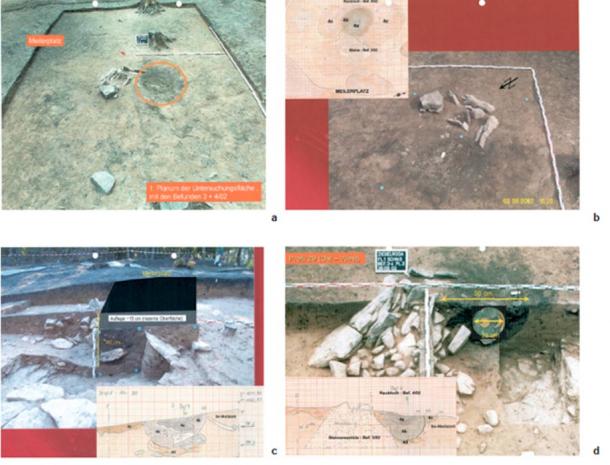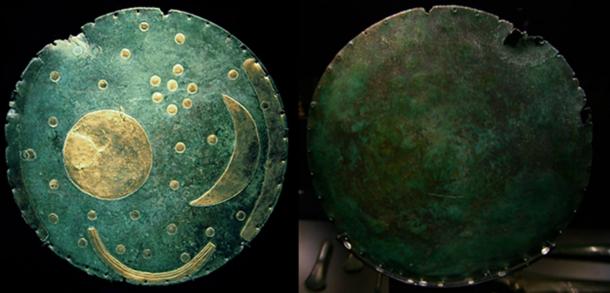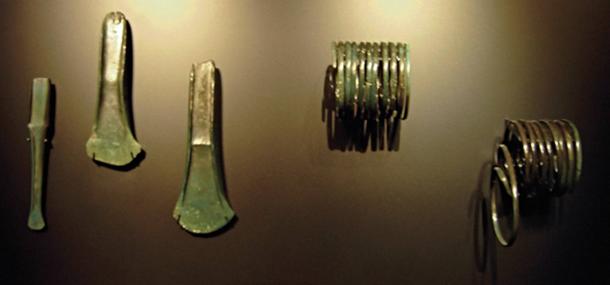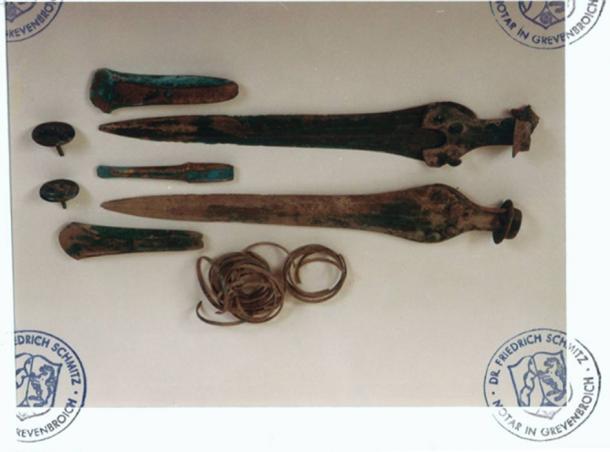Until today, the Nebra Sky Disk was known as the oldest concrete depiction of cosmic phenomena worldwide. Scholars believed it was a 3,600-year-old artifact depicting a sun or full moon, a lunar crescent, and stars – usually said to be the Pleiades. But a shocking new study has thrown out those understandings of the artifact, claiming the Nebra Sky Disk is 1000 years younger than commonly believed and stating that the previous astronomical interpretations are “obsolete.”
New Dating of the Nebra Sky Disk
The shocking new information about the Nebra Sky Disk comes from Rupert Gebhard, Director of the Munich Archäologischen Staatssammlung, and Rüdiger Krause Professor for Prehistory and Early European History at Goethe University Frankfurt. A press release by the university states that the researchers have found “the disk must be dated in the Iron Age, making it about 1,000 years younger than previously assumed. This makes all previous astronomical interpretations obsolete.”
A key cause of concern for the researchers is the context in which the artifact was found. According to the university’s press release, “This discovery context was important for the scientific dating, as the disk itself could neither be scientifically nor archeologically dated by comparison with other objects. Many years of investigations by several research groups therefore attempted to verify both the attribution to the supposed discovery site as well as the common origins of the objects independent of the vague information given by the looters.”

Excavation of a looters’ pit on the Mittelberg near Nebra. Documents for presentation at the court hearing (estate expert opinion Josef Riederer, Archiv Archäologische Staatssammlung Munich). a) Investigation area excavated in the first planum. At the cut edge the approx. 15 cm thick humus layer is recognizable. b) Planum detail. The looters’ pit is clearly demarcated as a limited disturbed zone within a find context. c) Representation of the recent surface above the find. d) Projection of the sky disk into the deepest point of the find context without consideration of the supportive humus, in which according to the finders the upper part of the disk was located. ( Archäologische Informationen )
After an extensive study of the circumstances surrounding the Nebra Sky Disk’s discovery and previous research on the artifact, Gebhard and Krause came to the surprising conclusion that:
“The site that was considered the discovery site until today and which was investigated in subsequent excavations is with high probability not the discovery site of the looters. Furthermore, there is no convincing evidence that the Bronze Age swords, axes and bracelets form an ensemble of common origins. For this reason, it must be assumed that this is not a typical Bronze Age deposit and that the disk was not found together with the other objects in an original state at the excavation site.”
Furthermore, the researchers have concluded that the Nebra Sky Disk does not fit with Early Bronze Age motifs and it should be examined instead as an Iron Age artifact. As they state in their paper:
“The disk must be regarded as an individual object in itself with regard to dating, whereby it should be noted that no comparable symbolic material can be drawn forth for its classification in the Central European Early Bronze Age. Far more, if the origin from the Mittelberg could be confirmed, a dating also within the context of the Iron Age fortification as well as in the iconography would be obvious. Thus, the construct presented so far would lack meaning and function on any basis.”

Front (DBachmann/ CC BY SA 3.0 ) and back (Patrik Tschudin/ CC BY 2.0 ) of the Nebra Sky Disk.
The press release emphasizes that “on the basis of a divergent data situation and on the basis of this new assessment, all previous, sometimes far-reaching cultural-historical conclusions must be discussed anew and with an open mind, and the disk must be interpreted and evaluated in different contexts than before.”
This is a strong assertion and undoubtedly controversial, especially in light of the long-held beliefs surrounding this artifact that is included in UNESCO’s ‘ Memory of the World ’ register, an international initiative launched to safeguard the documentary heritage of humanity, and once called “one of the most important archaeological finds of the twentieth century.”
But this is not the first time the Nebra Sky Disk has created controversy. The disk is such an extraordinary piece that it was initially believed to be an archaeological forgery. Scientific studies have shown it is an authentic ancient artifact but as this new study shows other details of the Nebra Sky Disk are being questioned.
The Problem with Finding Context
The story behind the Nebra Sky Disk’s discovery begins in 1999. Two amateur treasure hunters are said to have made the impressive find while illegally using a metal detector in Ziegelroda Forest, Saxony-Anhalt, Germany.
Reports say it had been ritually buried in a prehistoric enclosure atop a hill (the Mittelberg), along with two precious swords, two axes, two spiral arm-rings and one bronze chisel (more on those artifacts in a moment). The enclosure is oriented in such a way that the sun seems to set every solstice behind the Brocken, the highest peak of the Harz Mountains, some 80 km (49.71 miles) to the north-west. The surrounding area is known to have been settled since the Neolithic, and Ziegelroda Forest is said to contain around 1,000 barrows.

The chisel, axe heads, and arm-rings that were said to be found with the disc. ( DBachmann/CC BY SA 3.0 )
But the current study asserts there is a problem with ascertaining the real location where the Nebra Sky Disk was found. The paper explains “The history of its discovery was reconstructed according to information supplied by the first buyer and the finders of the object as well as to observations of traces of damage on the disc.” Furthermore, the researchers have noted that the supposed hoard of artifacts did not originally belong together. One past study has shown, for example, that a soil sample taken from one of the axes is “completely different” than the sample taken form the looter’s pit.
According to an initial analysis of trace elements by x-ray fluorescence by E. Pernicka, then at the University of Freiberg, the copper originated at Bischofshofen in Austria, while the gold was thought to be from the Carpathian Mountains. However, a more recent analysis found that the gold used in the first phase was from the river Carnon in Cornwall. The tin content of the bronze was also from Cornwall.
The scientific studies of the Nebra hoard, as it is generally, but perhaps incorrectly known, are probably among the most thorough ever carried out on any archaeological find in Europe. Study began when the objects were first impounded in 2002 and continued until the end of 2007.

Bronze Age swords, axes and arm-rings allegedly found together with the Nebra Sky Disk. Condition before the finds were handed over to the Landesmuseum Halle. The correspondence of the photos with the originals was notarized on 25.1.2002. (Photo: Hildegard Burri-Bayer/ Archäologische Informationen )
Nevertheless, dating the artifact has posed many difficulties, and while past scientists determined that the disk was buried in 1,600 BC, the current study says that date is wrong, especially if the location of the discovery is Mittelberg. As the new paper explains, “Although only remains of an Iron Age fortification are present on the Mittelberg, no indications of any activity on or use of the mountain during the 2nd millennium BC were detected.”
The Motifs on the Nebra Sky Disk
The Nebra Sky Disk’s main point of interest has been its appearance and what it may represent. The artifact measures approximately 30 cm (11.81 inches) in diameter, weighs 2.2 kg (4.85 lbs.), and is decorated with a blue-green patina and inlaid with gold symbols. These have traditionally been interpreted as a sun or full moon, a lunar crescent, and stars (including a cluster said to show the Pleiades).
Two golden arcs along the sides were added later (one has since become lost). These were constructed from gold of a different origin, as shown by its chemical impurities. The two arcs span an angle of 82°, which past researchers have noted as a correct indication of the angle between the positions of sunset at summer and winter solstice at the latitude of the Mittelberg (51°N). A final addition was another arc at the bottom surrounded with multiple strokes of uncertain meaning, variously interpreted as a Solar Barge (“the sun boat”) with numerous oars, or as the Milky Way .

Mittelberg hill, where the Nebra Sky Disc was allegedly found. Photo credit: LDA Sachsen-Anhalt
By the time the disc was buried it also had 39 or 40 holes punched out around its perimeter, each approximately 3 mm in diameter. According to state archaeologist Harald Meller, it is likely the circular plate represents the sun , given that the arcs relate to solar phenomena. Gebhard and Krause disagree, and write that “The symbols on the sky disk of Nebra, oppositely, appear as a nocturnal-oriented subject, thus corresponding to the cultural environment of the 1st millennium BC.”
What was the Nebra Sky Disk?
The Nebra Sky Disc has traditionally been interpreted as a confirmation that the astronomical knowledge and abilities of the people who created it included close observation of the yearly course of the sun (or moon.) While much older earthworks and megalithic astronomical complexes, such as the Goseck circle or Stonehenge, had already been used to mark the solstices, the disc has generally been seen as the oldest known “portable instrument” to allow such measurements.
Astronomer Ralph Hansen maintains that the disc was an attempt to co-ordinate the solar and lunar calendars to tell the ancient people when to plant seeds and when to trades, giving them an almost modern sense of time. “For everyday calendrical purposes, you would use Moon years. But for designing when to plough fields and when to harvest, you use Sun years,” said Hansen.
However, not everyone agrees that the Nebra Sky Disk was even used for measuring astronomical phenomena. “It’s a difficult question to answer, but I do not think it was used as an instrument used for observing objects in the sky,” said Curt Roslund, an astronomer at Gothenburg. Instead, Roslund argues that few features on the disc tend towards exact representation and that it is more likely to have been of symbolic value – perhaps used in shamanic rituals.

The stages in the life of the Nebra Sky Disc. Photo credit: LDA Sachsen-Anhalt
Gebhard and Krause seem to support this notion and state that “Compared with ethnographic examples, the authors emphasize an underlying mythological, shamanistic world of thought, indeed, almost the opposite of a concrete astronomical interpretation.” They cite a 2007 study by Emília Pásztor and the aforementioned Curt Roslund, which they believe shows “that the “stars” depicted on the disk are evenly distributed and do not represent a concrete image of the sky” after all.
UNESCO’s interpretation of the Nebra Sky Disk finds a happy balance between those two prominent theories, suggesting that it “combines an extraordinary comprehension of astronomical phenomena with the religious beliefs of its period”, enabling us to gain “unique glimpses into the early knowledge of the heavens.”
Top Image: Front of the Nebra Sky Disk. Source: DBachmann/ CC BY SA 3.0
Updated on September 3, 2020.
Related posts:
Views: 0
 RSS Feed
RSS Feed

















 September 4th, 2020
September 4th, 2020  Awake Goy
Awake Goy  Posted in
Posted in  Tags:
Tags: 
















